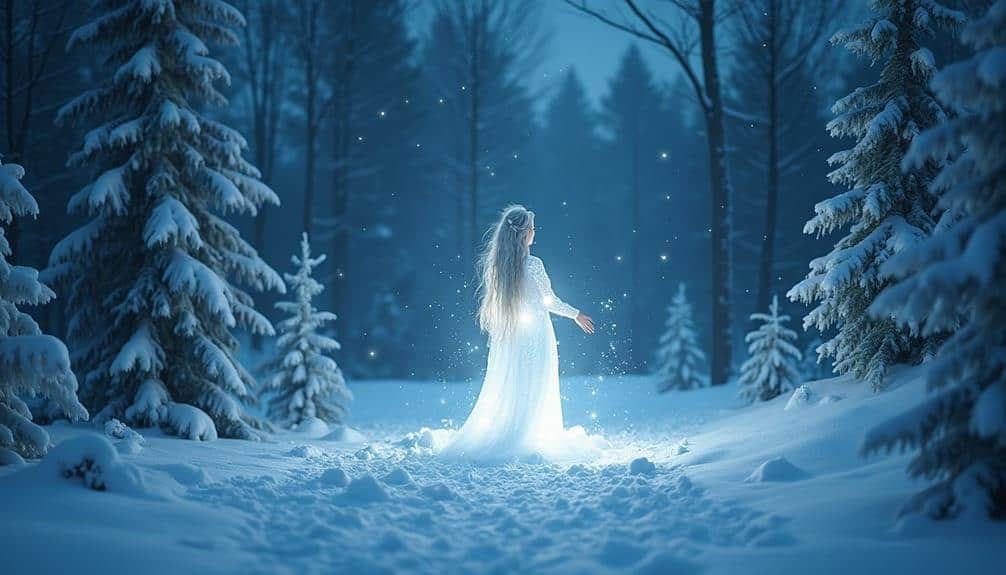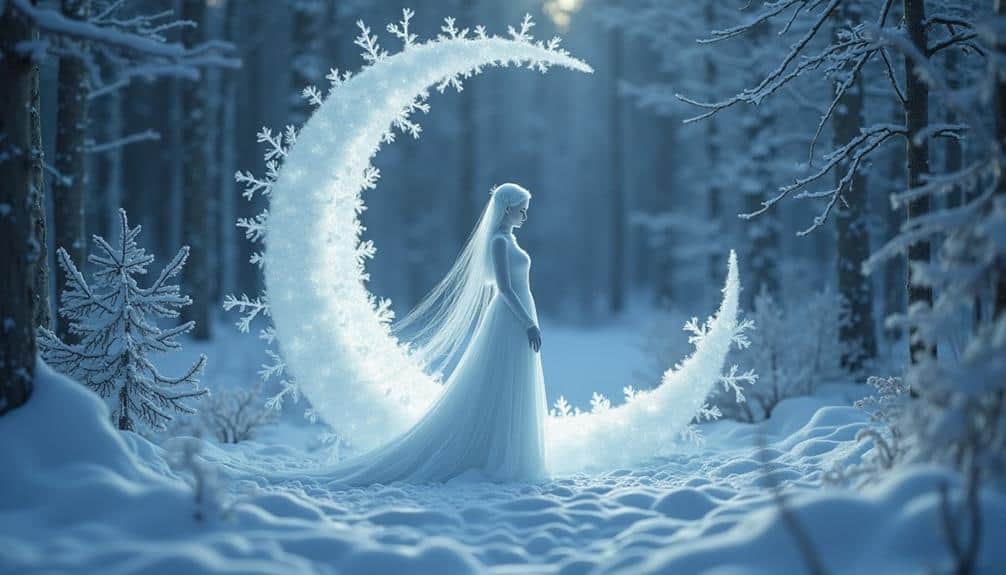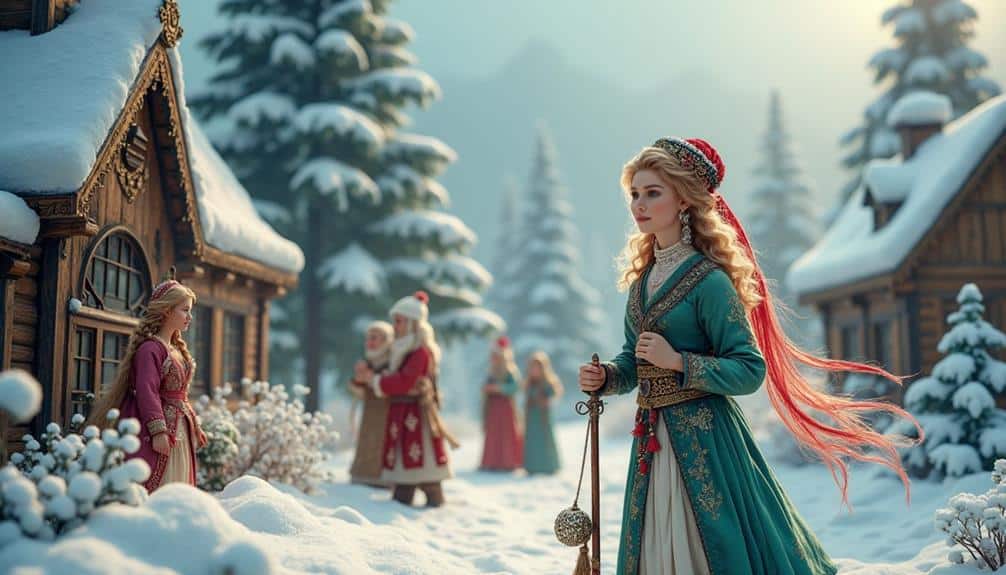You’re about to uncover the enigmatic tale of the Snow Maiden, rooted in Slavic mythology. This story isn’t just a simple winter legend; it’s a profound narrative intertwining themes of love, sacrifice, and the delicate balance of nature. Imagine a child made of snow, brought to life by a couple’s deep yearning, steering her existence with an innocent desire for human connection. When she falls for a shepherd named Lel, her journey takes a heart-wrenching turn. What happens when the purity of snow meets the warmth of love? Let’s explore the rich layers of this timeless story.
Origins and Mythology

The Snow Maiden, a figure steeped in folklore, has origins that trace back to the rich tapestry of Slavic mythology. Her story, deeply intertwined with the natural world, mirrors the rhythmic dance of seasonal change. In Slavic folklore, she embodies the purity and fragility of winter. You’ll find her emerging from the snow, created by the hands of a yearning couple who long for a child. This mystical genesis ties her directly to the cold, pristine essence of winter.
As you explore deeper into her myth, you’ll see how the Snow Maiden serves as a bridge between the starkness of winter and the renewal of spring. Her life is ephemeral, much like the fleeting beauty of snowflakes. When the warmth of spring encroaches, she inevitably melts away, symbolizing the end of winter and the coming of new life.
This cycle captures the heart of Slavic folklore, emphasizing the inevitable and natural shifts of the seasons. Understanding the Snow Maiden’s origins gives you a glimpse into how ancient Slavic cultures viewed nature. It’s a poetic reminder of the delicate balance and interconnectedness of life’s cycles.
Key Characters

When diving into the tale of the Snow Maiden, you’ll encounter a cast of key characters that breathe life into this enchanting story. Central to the narrative is the Snow Maiden herself, a mystical figure born from the essence of a magical winter. Her ethereal beauty and innocence capture the heart of anyone she meets, embodying the purity and chill of the Russian winter.
Father Frost, another pivotal character in Russian folklore, is often depicted as the Snow Maiden’s guardian or creator. He wields the power of winter, cloaking the land in snow and ice. His deep connection to the Snow Maiden highlights the magical winter element that permeates the tale.
Other characters include the kind-hearted villagers who discover the Snow Maiden. Their warmth and hospitality contrast sharply with the cold, emphasizing the blend of human kindness and supernatural elements.
Each character, from the mystical Snow Maiden to the formidable Father Frost, weaves together the rich tapestry of this beloved Russian folklore. They create a world where the harshness of winter is softened by the magic and warmth of human connection.
Plot Summary

In the enchanting tale of the Snow Maiden, you’ll find a story brimming with magic and heartfelt moments. The story begins with an elderly couple who long for a child. Their wish is granted when they create a girl out of snow, and she miraculously comes to life. Named Snegurochka, or Snow Maiden, she embodies innocence and purity.
As Snegurochka grows, her character motivations become clear—she desires human connection but struggles with her icy nature. Her yearning to experience love drives the plot forward. A significant plot twist occurs when Snegurochka falls in love with a shepherd named Lel. This newfound emotion triggers a conflict within her, as love and warmth threaten her very existence.
Another plot twist arises when Snegurochka seeks help from the goddess of spring, who grants her the ability to feel human emotions fully. However, this gift comes at a cost. As she warms to human feelings, she melts away, sacrificing herself for the brief experience of love.
The story concludes with a poignant realization that some desires come with irreversible consequences. Through its magical narrative, the Snow Maiden’s tale captivates with its blend of longing, love, and sacrifice.
Themes and Symbolism

Though the Snow Maiden’s tale is rich with magical elements, it explores deeply into themes of longing, love, and sacrifice. At its core, the story resonates with the universal desire for connection and belonging. The Snow Maiden, born from snow and brought to life through the wishes of a childless couple, embodies the theme of familial love. Her creation signifies the deep yearning for a child, and her presence brings immense joy to her adoptive parents.
However, her fate is tightly bound to the natural world. Nature symbolism plays a significant role in the narrative. The Snow Maiden’s very essence is linked to winter, cold, and purity. Her heart, initially frozen, symbolizes emotional detachment and the inability to experience human warmth fully.
As she begins to feel love and warmth, her transformation is inevitable and tragic. This change highlights the transient nature of life and the inevitable sacrifices that come with deep emotional connections.
Ultimately, the tale emphasizes that true love and human warmth come with risks and sacrifices. The Snow Maiden’s story serves as a poignant reminder that while familial love and longing can bring joy, they also entail profound loss and heartache.
Cultural Impact

The Snow Maiden story has left a lasting impression on various cultures, transcending its folkloric origins. You can see its cultural significance in the way it permeates seasonal traditions around the world.
In Russia, the Snow Maiden, or Snegurochka, is an essential part of New Year celebrations, often appearing alongside Grandfather Frost. This tradition underscores her role in bringing joy and magic during the winter season.
In other cultures, the tale has found its way into various holiday festivities. You’ll find echoes of the Snow Maiden in Western Christmas stories, where characters embodying the spirit of winter bring warmth and cheer.
These adaptations highlight how the story’s themes of transformation and renewal resonate across different cultural landscapes.
Modern Adaptations

While the cultural impact of the Snow Maiden story showcases its timeless appeal, modern adaptations breathe new life into this classic tale. You’ll find contemporary retellings that reimagine the Snow Maiden in diverse settings and formats, from literature to film.
These fresh perspectives keep the story relevant, exploring themes like identity, love, and sacrifice in ways that resonate with today’s audience.
Theatrical interpretations play a significant role in these adaptations. Modern theater productions often blend traditional Russian elements with innovative stage techniques, creating immersive experiences that captivate audiences.
You might see a Snow Maiden ballet with stunning choreography and elaborate costumes or a musical that infuses the narrative with original songs and modern dance.
Film adaptations also bring the Snow Maiden into the contemporary era. Directors often place her in modern-day settings, exploring what it means to navigate a world where magic and reality intertwine.
These films offer a visual feast, using special effects to bring the Snow Maiden’s icy domain to life.




